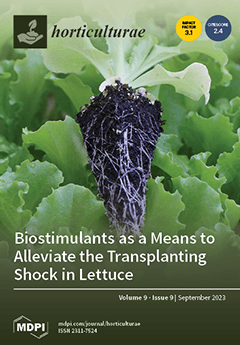The impact of exogenous sulfate components on the nutritional quality of vegetables has been well documented. In this study, we examined the effects of adding K
2SO
4 to broccoli on its nutritional quality, active components, and the genes involved in glucosinolate synthesis. Different concentrations of exogenous K
2SO
4 of 25, 75, and 150 g·m
−2 were applied to the “Naihan Youxiu” broccoli cultivar, while the control treatment received no potassium sulfate. Our primary objective was to gain insights into strategies for enhancing broccoli’s nutritional and active components. The results showed that broccoli’s vitamin C content in each treatment was lower than that in the control treatment. The contents of soluble protein, soluble sugar, polyphenols, and total flavonoids in the treatment of 150 g·m
−2 K
2SO
4 were the highest. They increased by 23.51%, 87.49%, 146.00%, and 22.73% more than the control, respectively. MDA was significantly inhibited after the 75 g·m
−2 treatment, whereas SOD had the highest activity under the 75 g·m
−2 treatment. Therefore, the 150 g·m
−2 treatment was beneficial in improving the nutritional quality and antioxidant capacity of broccoli. The contents of PRO, SIN, NAP, GBC, 4ME, NEO, total indole glucosinolates, and total glucosinolates reached the peak at the 150 g·m
−2 K
2SO
4 treatment, RAA and total aliphatic glucosinolates reached the peak at the 75 g·m
−2 K
2SO
4 treatment, and ERU and 4OH reached the highest at the 25 g·m
−2 K
2SO
4 treatment. The sulforaphane content was the highest in the 150 g·m
−2 treatment, and myrosinase activity was the highest in the 75 g·m
−2 treatment. It can be seen that the 150 g·m
−2 treatment significantly increased the content of glucosinolates, total indole glucosinolates, total glucosinolates, and sulforaphane in broccoli.
CYP79B2,
CYP83B1,
CYP83A1,
AOP2,
UGT74B1, and
MYB34 were significantly up-regulated under 150 g·m
−2 K
2SO
4 treatment and reached the peak value.
CYP79F1,
CYP81F4, and
MAM1 showed significant inhibitory effects when treated with 150 g·m
−2 of K
2SO
4. The expression levels of
BCAT4,
CYP81F1,
ST5a,
ST5c, and
SUR1 were down-regulated under the 150 g·m
−2 K
2SO
4 treatment, but not significantly. In summary, the K
2SO
4 150 g·m
−2 treatment had the best effect on nutritional quality, antioxidant activity, the content of glucosinolates, total glucosinolates, sulforaphane, and expression of
CYP79B2,
CYP83B1,
CYP83A1,
FMO2,
UGT74B1,
AOP2, and
MYB34 genes.
Full article





